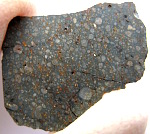Chondrites are the least altered of the various meteorite groups. They have not changed considerably since they formed in the early solar system. They all contain chondrules - small (usually less than a few millimetres at most) spherical inclusions made from hard crystallised minerals. They are divided into the following groups, the first three represent the "ordinary chondrites":
- H - High iron. Contains 25-30% iron. The rock will consist of 15-19% visible iron-nickel metal. For an example see the image of NWA 2710 (H5) in the "About Meteorites - Identification" section.
- L - Low iron. Contains 20-23% iron. The rock will consist of 1-10% visible iron-nickel metal. For an example see the image of Ghubara (L5) below.
- LL - Low iron, Low metal. Contains 19-22% iron. The rock will consist of 1-3% visible iron-nickel metal.
- C - Carbonaceous chondrites. Defined by their higher levels of Mg, Ca and Al relative to Silicon in comparison to the ordinary chondrites. This group contains some of the most complex meteorites known. They are the most primitive type of meteorite, some matching the (non-volatile) composition of the Sun very closely. Others have been found to contain amino acids. Some carbonaceous stones contain calcium-aluminium inclusions (CAI's) which were among the very first materials to accrete during the formation of our solar system. This group is sub-divided into CI, CM, CV, CO, CR, CK, CB and CH types. (Image shows a 6.7g half stone of Allende, CV3. An irregular shaped CAI is visible at the bottom right edge of the cut face)
|  |
- E - Enstatite chondrites. Formed with very little oxygen present, meaning that most of the iron present (22-23% by weight) is in the form of metal. Group is sub-divided into EH and EL chondrites.
- R - Rumurutiites. A rare classification and the most oxidised of all chondrites. contain little or no free iron. (Image shows a 1.2g part slice of NWA 5584, R3.8, with clearly visible chondrules)
|  |
- K - Kakangariites. This group only consists of two members and is extremely rare.
| Many chondrites are also given a number (a "petrographic type" from 3 to 7) representing how much the chondrules have been changed (metamorphosed) by heating after they initially formed. 3 represents the least changed chondrules, 7 means they have been partially or completely melted. The image shows a 2.42g part slice of Ghubara, petrographic type 5. Compare the barely visible chondrules in this highly metamorphosed meteorite to the pristine examples visible in NWA 2377, petrographic type 3.7, in the 'About Meteorites - Identification' section above.
|  |
Some carbonaceous chondrites are given a petrographic type of 1 or 2, where 1 is the most altered, showing that they have been altered by the presence of water during their formation. This is known as "aqueous alteration".
|

